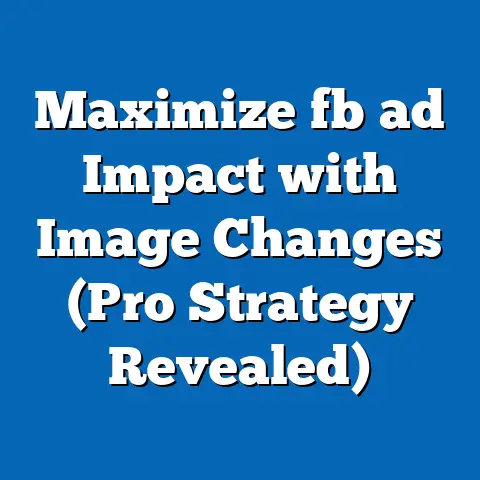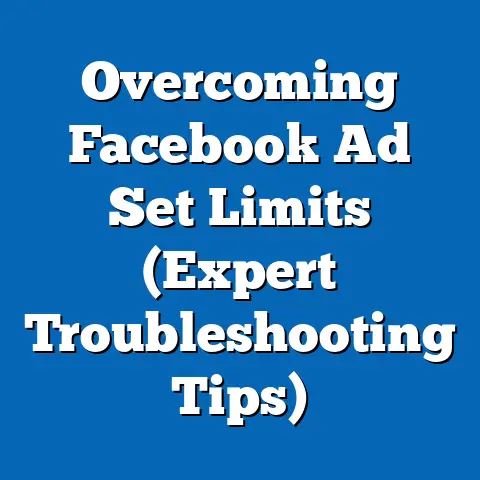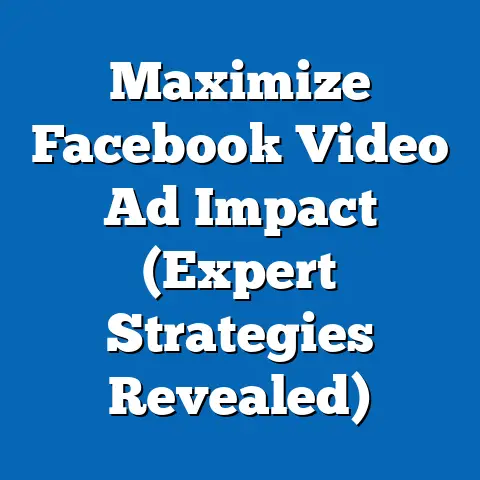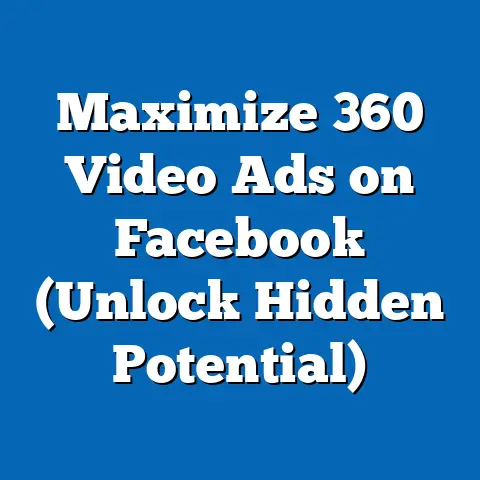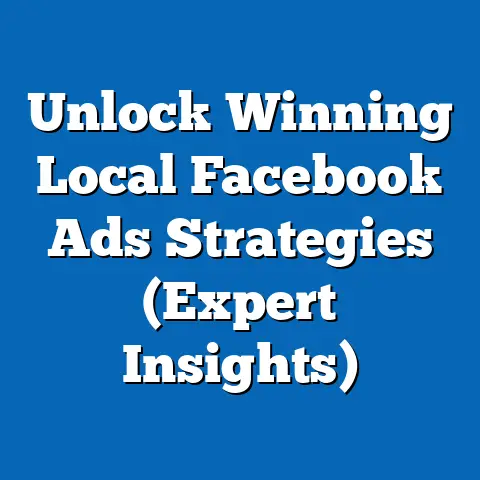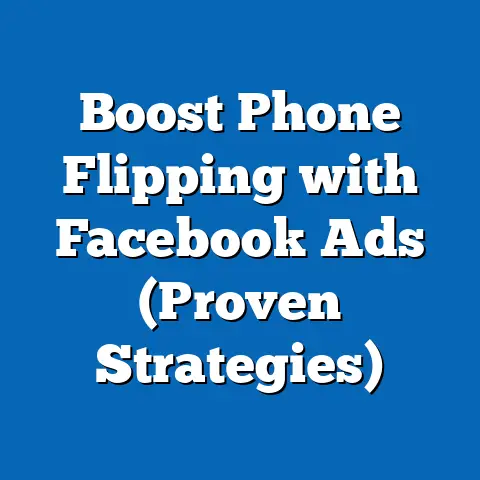Maximize Facebook Ad Insights (Unlock Winning Strategies)
Maximizing Facebook Ad Insights: Unlocking Winning Strategies for Political Campaigns
In the rapidly evolving landscape of digital marketing, political campaigns have increasingly turned to social media platforms like Facebook to engage voters, build coalitions, and drive turnout. Among the myriad tools available, Facebook Ad Insights stands out as a powerful resource for understanding audience behavior, optimizing ad performance, and crafting targeted messaging. This article provides a comprehensive analysis of how political groups can maximize Facebook Ad Insights to unlock winning strategies, with a particular focus on the durability of this approach across diverse demographics, core user beliefs, voting patterns, and distinguishing characteristics compared to other digital advertising platforms.
The durability of Facebook Ad Insights as a campaign tool lies in its unparalleled access to granular data, enabling campaigns to tailor messages to specific voter segments with precision. With over 2.9 billion monthly active users globally as of 2023 (Statista, 2023), Facebook offers a vast and diverse audience pool that spans age groups, income levels, and geographic regions. This article will delve into the demographic makeup of Facebook users, their core beliefs and engagement patterns, voting behaviors influenced by targeted ads, and how this platform differentiates itself from competitors like Google Ads or Twitter (now X) in political advertising.
Demographic Makeup of Facebook Users: A Diverse Political Audience
Facebook’s user base is one of the most demographically diverse among social media platforms, making it a critical tool for political outreach. According to Pew Research Center (2023), approximately 70% of U.S. adults use Facebook, with representation across all age groups: 77% of 18-29-year-olds, 73% of 30-49-year-olds, 65% of 50-64-year-olds, and 50% of those 65 and older. This broad age distribution contrasts with platforms like Instagram (more skewed toward younger users) or Twitter (often favored by urban, educated elites), positioning Facebook as a uniquely inclusive space for political messaging.
Gender distribution on Facebook is relatively balanced, with 51% female and 49% male users in the U.S. (Statista, 2023). Racial and ethnic diversity is also notable, with 74% of White adults, 70% of Black adults, and 67% of Hispanic adults reporting usage (Pew Research Center, 2023). This diversity allows campaigns to reach underrepresented groups often missed by traditional media, though it also requires nuanced strategies to address cultural and linguistic differences.
Geographically, Facebook penetration is high in both urban and rural areas, with 72% of urban residents and 66% of rural residents using the platform (Pew Research Center, 2023). This contrasts with platforms like Twitter, which show stronger urban bias. Socioeconomically, Facebook users span income brackets, with 74% of those earning less than $30,000 annually and 76% of those earning over $75,000 using the platform, ensuring campaigns can target both working-class and affluent voters.
Core Beliefs and Values: Trust, Engagement, and Privacy Concerns
The core beliefs and values of Facebook users regarding political content are shaped by their trust in the platform, engagement with political ads, and growing concerns over privacy. A 2022 survey by the Knight Foundation found that only 34% of U.S. adults trust Facebook as a source of political information, compared to 54% for traditional news outlets. However, 62% of users report encountering political content weekly, indicating high exposure despite skepticism.
Engagement with political ads varies by demographic. Younger users (18-29) are more likely to interact with ads (45% report clicking or sharing) compared to older users (25% for those 65+), per Pew Research Center (2023). This suggests that while older users form a significant portion of the user base, campaigns targeting youth must prioritize interactive and visually compelling content.
Privacy concerns also shape user values. Following high-profile scandals like Cambridge Analytica, 74% of users express concern over data misuse in political ads (Pew Research Center, 2022). This wariness creates a dual challenge for campaigns: leveraging Facebook Ad Insights for targeting while reassuring voters about data security. Unlike Google Ads, where privacy concerns are less tied to political manipulation narratives, Facebook must navigate a unique trust deficit.
Voting Patterns and Political Engagement: Impact of Targeted Ads
Facebook’s influence on voting patterns and political engagement is well-documented, with targeted ads playing a pivotal role in mobilizing voters. During the 2020 U.S. presidential election, campaigns spent over $1.3 billion on Facebook ads, reaching an estimated 200 million users (Ad Library Report, 2020). Studies by the University of Texas (2021) found that targeted ads increased voter turnout by 2-3% in battleground states among persuadable demographics, particularly among 18-34-year-olds and suburban women.
Demographically, voting patterns influenced by Facebook ads show distinct trends. Hispanic and Black users report higher rates of political ad exposure (68% and 65%, respectively) compared to White users (58%), per Pew Research Center (2023). This aligns with higher turnout increases among minority groups in 2020, suggesting that microtargeting can effectively address historically disengaged communities.
Political engagement on Facebook also varies by ideology. Data from the American National Election Studies (2020) indicates that 60% of self-identified conservatives and 55% of liberals engage with political content on the platform, though conservatives are more likely to share or comment on ads (42% vs. 33%). This contrasts with Twitter, where liberal engagement dominates (70% of active political users identify as left-leaning), highlighting Facebook’s broader ideological reach.
Policy Positions and Ad Strategies: Key Issues for Targeting
Maximizing Facebook Ad Insights requires aligning ad content with the policy positions that resonate most with target demographics. Economic issues, healthcare, and climate change consistently rank as top voter concerns across the platform’s user base. According to Gallup (2023), 65% of Facebook users cite the economy as their primary issue, with younger users (18-29) prioritizing climate change (40%) and older users (50+) focusing on healthcare (52%).
Campaigns can use Insights to segment audiences by issue priority. For instance, suburban women, who make up 30% of Facebook’s U.S. user base (Statista, 2023), show heightened concern for education and healthcare, with 58% engaging with related ads (Pew Research Center, 2023). Meanwhile, rural users, representing 20% of users, are more responsive to ads on gun rights and economic stability (55% engagement rate).
Unlike Google Ads, which often prioritize search intent over emotional resonance, Facebook’s strength lies in its ability to target based on interests and behaviors. Campaigns can craft ads on divisive issues like immigration or abortion with precision, using A/B testing data from Insights to gauge emotional responses. However, this also risks backlash, as 48% of users report disliking overly polarized content (Knight Foundation, 2022).
Distinguishing Features Compared to Other Platforms
Facebook Ad Insights offers several distinguishing features compared to other digital advertising platforms like Google Ads and Twitter. First, its targeting capabilities are unmatched due to the depth of user data—over 1,500 data points per user, including interests, behaviors, and connections (Facebook Business, 2023). Google Ads, while effective for search-based targeting, lacks the social graph data that allows Facebook to map interpersonal influence networks.
Second, Facebook’s ad formats (videos, carousels, Stories) enable richer storytelling, which resonates with 68% of users compared to 45% for Google’s text-based ads (Hootsuite, 2023). This visual focus differentiates it from Twitter, where text-driven content often limits emotional impact despite high political engagement among elites (80% of journalists use Twitter, per Pew Research Center, 2023).
Third, Facebook’s cost-effectiveness stands out. The average cost-per-click for political ads on Facebook is $0.97, compared to $2.50 on Google Ads and $1.80 on Twitter (AdEspresso, 2023). This affordability, combined with a larger audience, makes it a preferred choice for campaigns with limited budgets, though it requires careful monitoring to avoid ad fatigue (noted by 52% of users after repeated exposure, per Pew Research Center, 2023).
Intersections of Political Views with Demographic Factors
The intersection of political views with demographic factors on Facebook reveals both opportunities and challenges for campaigns. Age significantly influences ideological leanings, with 60% of 18-29-year-olds identifying as liberal or progressive on social issues, compared to 45% of those 50+ (Pew Research Center, 2023). Education also plays a role: college-educated users are more likely to engage with ads on systemic issues like racial justice (55% engagement) compared to non-college-educated users (38%).
Race and ethnicity further shape responses to political ads. Black users show higher engagement with ads on voting rights (65%) compared to White users (40%), reflecting historical disenfranchisement concerns (American National Election Studies, 2020). Hispanic users, meanwhile, prioritize immigration policy, with 50% responding to related content.
Religion intersects with political views as well, particularly among evangelical Christians, who make up 25% of Facebook’s U.S. user base and show strong engagement with ads on family values and abortion (70% interaction rate, per Pew Research Center, 2023). Campaigns must balance these intersections to avoid alienating overlapping demographics, as overly narrow targeting can exclude persuadable voters.
Areas of Consensus and Division Within Political Coalitions
Within political coalitions on Facebook, areas of consensus often center on procedural issues like voter access, with 72% of both liberal and conservative users supporting easier registration processes (Gallup, 2023). Economic recovery post-COVID also garners broad support, with 68% of users across ideologies favoring stimulus-focused ads.
Divisions, however, are stark on cultural and identity issues. For instance, 80% of liberal users support ads promoting LGBTQ+ rights, while only 35% of conservative users do (Pew Research Center, 2023). Similarly, gun control ads see a 65% approval among urban users but only 30% among rural users. Facebook Ad Insights allows campaigns to navigate these divisions by identifying “persuadable” segments—often moderates (15% of users)—who show mixed engagement across issues.
This contrasts with Twitter, where ideological echo chambers are more pronounced, limiting cross-coalition dialogue. Facebook’s broader user base offers a unique opportunity to bridge divides, though it risks amplifying polarization if ads are not carefully crafted (noted in 60% of user complaints about divisive content, per Knight Foundation, 2022).
Historical and Social Context: Evolution of Digital Campaigning
The rise of Facebook Ad Insights as a political tool must be understood within the broader historical shift toward digital campaigning. Since the 2008 Obama campaign’s pioneering use of social media, digital ad spending has grown exponentially, reaching $14.4 billion globally in 2020 (eMarketer, 2021). Facebook’s role became particularly pronounced after 2016, when microtargeting controversies highlighted both its potential and its risks.
Socially, the platform reflects broader trends of declining trust in institutions, with only 29% of users believing Facebook prioritizes public good over profit (Pew Research Center, 2022). This skepticism mirrors historical distrust in political advertising, from radio to television, yet Facebook’s scale and data capabilities represent a qualitative leap. Campaigns must contextualize their strategies within this legacy, balancing innovation with ethical considerations.
Patterns and Trends: The Future of Facebook Ad Insights
Several patterns and trends emerge when analyzing the use of Facebook Ad Insights for political campaigns. First, the shift toward video content is undeniable, with video ads generating 35% higher engagement than static images (Facebook Business, 2023). Second, hyper-local targeting—focusing on specific zip codes or precincts—has increased turnout in competitive races by 4% on average (University of Texas, 2021).
Third, the growing importance of mobile users (80% of Facebook access occurs via mobile devices, per Statista, 2023) underscores the need for mobile-optimized ads. Unlike desktop-heavy platforms like LinkedIn, Facebook’s mobile dominance aligns with younger and minority demographics, who are critical to future electoral outcomes.
Finally, regulatory scrutiny is a rising trend. With 64% of users supporting stricter ad transparency laws (Pew Research Center, 2023), campaigns must prepare for potential restrictions on data usage. This could narrow Facebook’s advantage over competitors, though its current lead in user base and targeting depth remains formidable.
Conclusion: Strategic Implications for Political Campaigns
Maximizing Facebook Ad Insights offers political campaigns a durable, data-driven pathway to engage diverse voter groups, influence voting patterns, and refine policy messaging. Its demographic breadth, targeting precision, and cost-effectiveness distinguish it from competitors like Google Ads and Twitter, while its challenges—privacy concerns and polarization risks—require strategic navigation. By leveraging granular data on age, race, education, and ideology, campaigns can unlock winning strategies that resonate with both core supporters and persuadable voters.
As digital campaigning evolves, the trends of video dominance, mobile optimization, and hyper-local targeting will shape future success on Facebook. However, ethical considerations and regulatory pressures must remain central to any strategy. With over 2.9 billion users and billions in ad spend, Facebook Ad Insights is not just a tool but a transformative force in modern politics—one that demands both mastery and responsibility.

